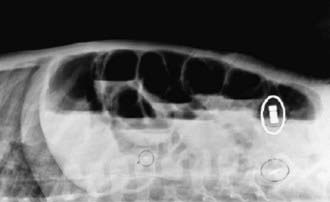Chapter 326 Foreign Bodies and Bezoars
326.1 Foreign Bodies in the Stomach and Intestine
Certain objects pose more risk than others. In cases of sharp foreign bodies, such as straight pins, weekly assessments are required. Surgical removal is necessary if the patient develops symptoms or signs of obstruction or perforation or if the foreign body fails to progress for several weeks. Small magnets used to secure earrings have been associated with bowel perforation. When the multiple magnets disperse after ingestion, they may be attracted to each other across bowel wall, leading to pressure necrosis and perforation (Fig. 326-1). Inexpensive toy medallions containing lead can lead to lead toxicity. Newer coins can also decompose when subjected to prolonged acid exposure. Unless multiple coins are ingested; however, the metals released are unlikely to pose a clinical risk.
Aktay AN, Werlin SL. Penetration of the stomach by an accidentally ingested straight pin. J Pediatr Gastroenterol Nutr. 2002;34:81-82.
Centers for Disease Control and Prevention. Gastrointestinal injuries from magnet ingestion in children—United States, 2003–2006. MMWR. 2006;55:1296-1300.
Cerri RW, Liacouras CA. Evaluation and management of foreign bodies in the upper gastrointestinal tract. Pediatr Case Rev. 2003;3:150-156.
Dutta S, Barzin A. Multiple magnet ingestion as a source of severe gastrointestinal complications requiring surgical intervention. Arch Pediatr Adolesc Med. 2008;162:123-125.
Karjoo M, Kader H. A novel technique for closing and removing an open safety pin from the stomach. Gastrointest Endosc. 2003;57:627-629.
Mallon PT, White JS, Thompson RL. Systemic absorption of lithium following ingestion of a lithium button battery. Hum Exp Toxicol. 2004;23:193-195.
Puig S, Scharitzer M, Cengiz K, et al. Effects of gastric acid on euro coins: chemical reaction and radiographic appearance after ingestion by infants and children. Emerg Med J. 2004;21:553-556.
Schalamon J, Haxhija EQ, Ainoedhofer H, et al. The use of a hand-held metal detector for localisation of ingested metallic foreign bodies—a critical investigation. Eur J Pediatr. 2004;163:257-259.
VanArsdale JL, Leiker RD, Kohn M, et al. Lead poisoning from a toy necklace. Pediatrics. 2004;114:1096-1099.
326.2 Bezoars
Kaneko H, Tomomasa T, Kubota Y, et al. Pharmacobezoar complicating treatment with sodium alginate. J Gastroenterol. 2004;39:69-71.
Lynch KA, Feola PG, Guenther E. Gastric trichobezoar: an important cause of abdominal pain presenting to the pediatric emergency department. Pediatr Emerg Care. 2003;19(5):343-347.
Palanivelu C, Rangarajan M, Senthilkumar R, et al. Trichobezoars in the stomach and ileum and their laparoscopy-assisted removal: a bizarre case. Singapore Med J. 2007;48(2):e37-e39.





